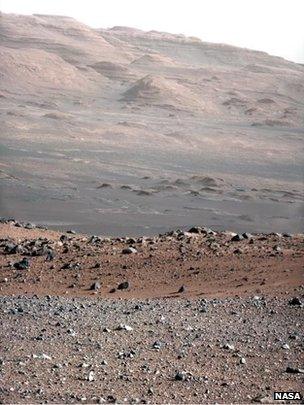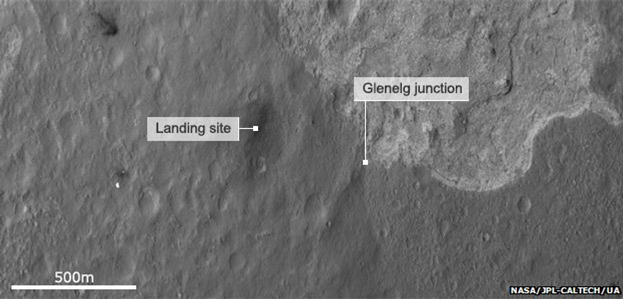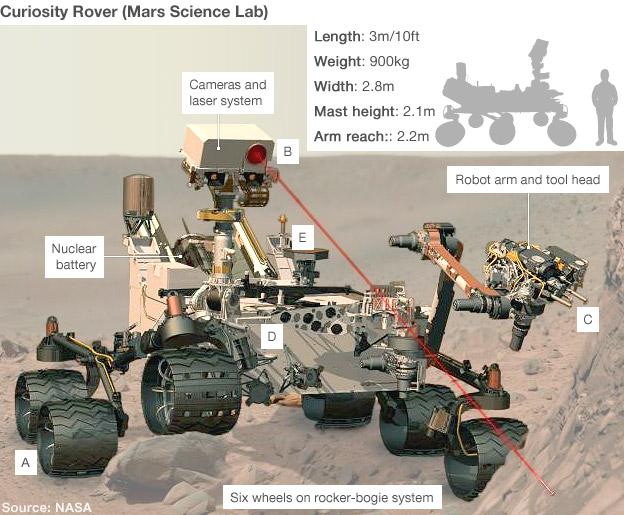Curiosity rover's intriguing geological find
- Published

The rover has spotted an "unconformity" in the layers of Mount Sharp, towering above Gale Crater
The Mars rover Curiosity is indulging in a flurry of multimedia activity ahead of its science mission proper.
It sent the first image from its 100mm telephoto lens, already spotting an intriguing geological "unconformity".
Nasa also released a colour panorama of Mount Sharp, the rover's ultimate goal.
On Monday, the rover relayed "the first voice recording to be sent from another planet", and on Tuesday it will broadcast a song from artist will.i.am as part of an educational event.
But alongside these show pieces, Curiosity - also known as the Mars Science Laboratory - is already warming up its instruments for a science mission of unprecedented scope on the Red Planet.
Nasa said that the rover was already returning more data from Mars than all of the agency's earlier rovers combined.
It will eventually trundle to the base of Mount Sharp, the 5km-high peak at the centre of Gale Crater, in which the rover touched down just over three weeks ago.
For now it is examining the "scour marks" left by the rocket-powered crane that lowered the rover on to the planet's surface, giving some insight into what lies just below the top soil.
The rover will now employ its Dan instrument, external, which fires the subatomic particles neutrons at the surface to examine levels of hydrogen- and hydroxyl-containing minerals that could hint at Mars' prior water-rich history.
Another tool in its arsenal, the ChemCam, external, which uses a focussed laser to vapourise rock and then chemically examine the "plasma" that results, will also have a look at the scour marks.
And the Sample Analysis at Mars, or Sam instrument, external, itself a package of three analysis tools, has now been switched on and is being run through its paces ahead of "sniffing" the Martian atmosphere; the tests include analysing a sample of Earth air that was left in it at launch.
But what has caught the interest of Nasa engineers already is what is called an unconformity spotted in the rover's first telephoto images of Mount Sharp.

White dots mark the line between two different geological "strata"
The term refers to an evidently missing piece in the geological record, where one layer of sediment does not geologically neatly line up with that above it.
Images from orbit had indicated that the lower foothills of Mount Sharp consisted of flat-lying sediments rich in "hydrated" minerals, formed in the presence of water, but that layers above seemed to lack these minerals.
Now, the rover's Mastcam - which also provided the new 34mm colour panorama image - has taken a picture with its 100mm lens of the divide, showing sediments apparently deposited at a markedly different angle from those below them. Similar deposits on Earth can arise due to tectonic or volcanic activity.
Further investigation will have to wait some time however, as Curiosity takes a bit of a side trip.

The panorama from the rover's 34mm camera shows the top of Mount Sharp, and the long drive to get there
The rover's multimedia streak will continue as it takes a short 10m drive and works on Tuesday to capture stereo imagery - like our eyes, combining two images to gain information about depth and distance.
At 20:00 GMT (13:00 PDT, 21:00 BST), it will relay a new song from will.i.am, to be broadcast on Nasa TV, external, as part of a primary educational initiative that will make use of Nasa technology including the rover.
On Monday, the rover received and beamed back a message recorded by Nasa administrator, Charles Bolden, which read: "The knowledge we hope to gain from our observation and analysis of Gale Crater will tell us much about the possibility of life on Mars as well as the past and future possibilities for our own planet."
Next stop for the rover will be Glenelg, 400m to the east, which appears to be the intersection of three distinct geological regions - potentially rich pickings for the rover's suite of tools.
It will then set off for the base of Mount Sharp in a journey that will take several months.


(A) Curiosity will trundle around its landing site looking for interesting rock features to study. Its top speed is about 4cm/s
(B) This mission has 17 cameras. They will identify particular targets, and a laser will zap those rocks to probe their chemistry
(C) If the signal is significant, Curiosity will swing over instruments on its arm for close-up investigation. These include a microscope
(D) Samples drilled from rock, or scooped from the soil, can be delivered to two hi-tech analysis labs inside the rover body
(E) The results are sent to Earth through antennas on the rover deck. Return commands tell the rover where it should drive next
- Published22 August 2012
- Published7 June 2012
- Published21 August 2012
- Published20 August 2012
- Published20 August 2012
- Published17 August 2012
- Published14 August 2012
- Published13 August 2012
- Published11 August 2012
- Published9 August 2012
- Published9 August 2012
- Published8 August 2012
- Published7 August 2012
- Published7 August 2012
- Published6 August 2012
- Published6 August 2012
- Published4 August 2012